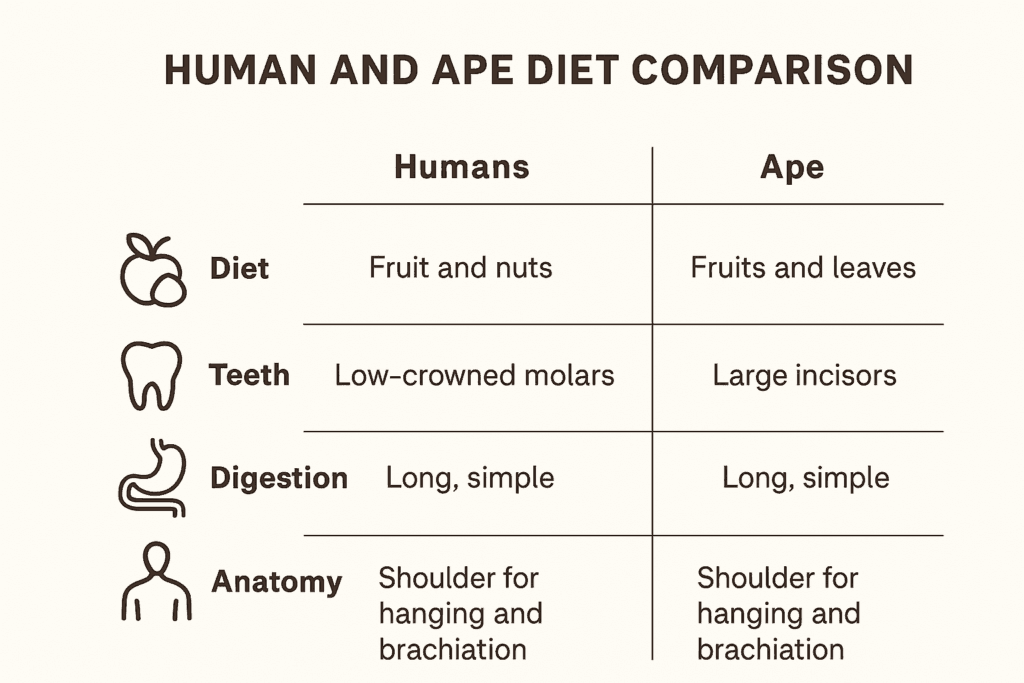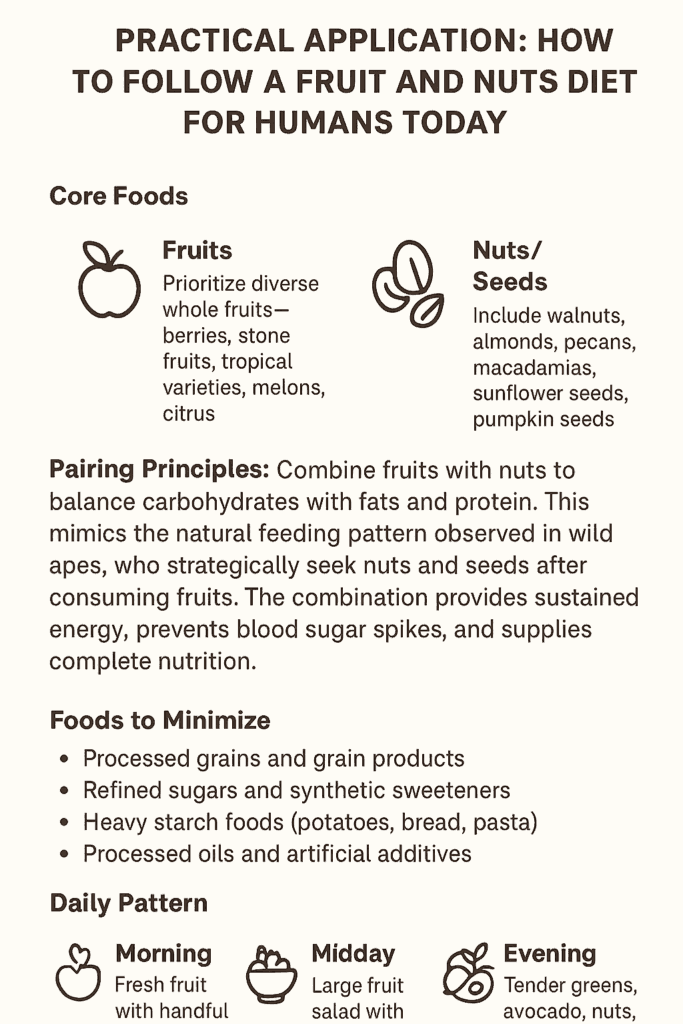Introduction: What Anatomy Reveals About the Fruit and Nuts Diet for Humans
Comparative anatomy reveals a startling truth: humans share nearly identical structural features with fruit-eating primates, suggesting we evolved for a specific dietary pattern. When scientists examine our skeletal structure, digestive organs, and cellular composition, they discover that human frugivore anatomy matches that of great apes in virtually every measurable characteristic. This raises a compelling question: are humans frugivores by biological design?
The evidence suggests that the fruit and nuts diet for humans isn’t merely a modern health trend but represents our ancestral blueprint. Throughout this analysis, we’ll conduct a comprehensive Human and Ape Diet Comparison, examining how our teeth, jaws, digestive tracts, and metabolic systems align with those of our closest evolutionary relatives.
Man’s Place in Nature: Authorities Supporting the Human Frugivore Anatomy Model
The renowned scientist Haeckel observed: “Whatever part of the body we consider, we find, upon the most exact examination, that man is more nearly related to the highest apes (pure frugivora) than are the latter to the lowest apes.” Between humans and anthropoid apes exists “the closest anatomical and physiological resemblances. In form and function there is the most exact agreement between all the corresponding bones of the skeleton of each; the same arrangement and structure of the muscles, nerves and entire viscera.”

Darwin further confirmed that the minute structure of the skin, nails, and even the hair, is identical in character between humans and anthropoid apes. These authorities collectively demonstrate that humans are frugivores and isn’t merely a philosophical speculation but scientific observation supported by anatomical evidence.
Core Comparative Anatomy: Structural Evidence for the Fruit and Nuts Diet for Humans
This section demonstrates how specific anatomical traits directly support the fruit and nuts diet for humans as our natural nutritional pattern.
Skeletal Structure and Jaw Mechanics
Human frugivore anatomy becomes immediately apparent when examining skull shape and jaw function. Humans possess rounded dental arches and jaw joints positioned for side-to-side grinding motions—the exact mechanical pattern frugivorous primates use for processing plant materials. Our temporomandibular joints allow extensive lateral movement, enabling the thorough mastication that fruits and fibrous plant foods require.
Contrast this with carnivores, whose jaw joints function like hinges, restricting movement to vertical chopping motions designed for shearing flesh. Our shoulder structure further reveals frugivorous adaptation, providing the mobility necessary for climbing and reaching—behaviors associated with harvesting fruits from trees rather than pursuing prey.
Digestive Tract Architecture
The human gastrointestinal system provides perhaps the most compelling anatomical evidence. Carnivores possess short digestive tracts measuring only 3-6 times their body length. Herbivores develop extremely long intestines—up to 20-28 times body length—with specialized fermenting chambers.
Frugivorous primates, including chimpanzees, bonobos, and orangutans, maintain long, relatively simple digestive tracts measuring 10-12 times body length. Humans fall precisely within this range, sharing the smooth, uncomplicated intestinal structure of fruit-eating apes. Under the microscope, human blood corpuscles appear identical in form and appearance to those of anthropoid apes, while those of the carnivora are clearly different from them. This similarity supports the theory of evolution and the close relationship between humans and apes.
Eye Structure and Sensory Adaptation
Human vision exhibits optimization for color detection—the primary mechanism frugivores use for identifying ripe fruits. We possess trichromatic vision that distinguishes subtle color variations, enabling us to select foods at peak nutritional value. Carnivores display fundamentally different visual adaptations: enhanced night vision, motion-tracking specialization, and reduced color discrimination.
Digestive Design: Direct Evidence for a Fruit and Nuts Diet for Humans
Dentition Pattern and Mastication
The Human and Ape Diet Comparison becomes crystal clear when examining dental structure. Humans possess broad incisors perfectly designed for biting into soft fruits, low rounded molars optimized for grinding plant material, and moderate canines suitable for tearing fibrous foods. We lack the shearing carnassials carnivores use for cutting meat, the high-crowned molars ruminants need for grinding tough grasses, and the specialized cutting teeth which true omnivores possess.
Dental Comparison:
- Frugivores (humans/apes): Large flat incisors, low rounded molars
- Carnivores: Sharp pointed incisors, carnassial shearing teeth
- Herbivores: Small incisors, extremely high-crowned molars
Stomach Structure and Enzymatic Profile
Humans possess single-chambered stomachs identical to those of frugivorous apes—simple, acidic environments designed for breaking down watery plant foods. Our stomach pH registers around 4-5, matching frugivorous primates and indicating adaptation for foods requiring moderate digestive conditions.
Humans produce high levels of salivary amylase—an enzyme that begins breaking down natural sugars found in fruits immediately upon entering the mouth. We also generate substantial lipase for processing the oils found in nuts and seeds. Conversely, humans lack the powerful proteolytic enzymes and extremely acidic stomachs (pH 1-2) that carnivores require for breaking down raw meat and bones.
Natural Diet of Anthropoid Apes: Foundation for the Fruit and Nuts Diet for Humans
Observing wild ape diets provides strong validation of the fruit and nuts diet for humans. These primates demonstrate through their feeding behavior what our shared anatomy predicts.
Research documents that gibbons prefer fruits and roots. In the wild state they refuse animal food (flesh), but are extremely fond of insects. Their natural diet consists primarily of fruits, nuts, and tender leaves, with occasional insects providing supplemental protein. A range of natural ways to strengthen immunity stem from similar fruit-rich, plant-forward eating patterns.
Field observations by naturalist A.R. Wallace reveal that orangutan food consists almost exclusively of fruit, with occasional leaves, buds, and young shoots. Remarkably, in other cases they eat only the small seed of a large fruit, demonstrating selective feeding for specific nutrients. When orangutans have consumed sufficient carbohydrates from fruits, they selectively seek seeds and nuts for oils and protein.
DuChaillu’s research documents that gorillas consume fruits, seeds, nuts, and banana leaves. Most significantly, notwithstanding its powerful canine teeth, and its extraordinary strength, the gorilla is really an exclusively frugivorous animal. Gorillas build massive muscle mass entirely on plant foods, demonstrating that the fruit and nuts diet for humans can support robust physical development.
The pattern across all great apes reveals strategic use of seeds and nuts for balancing the nutritional profile of fruit-heavy diets. Nuts provide concentrated oils, complete proteins, and essential minerals that complement the carbohydrates, vitamins, and fiber fruits supply.
Why Apes (and Early Humans) Did Not Eat Grains
The question are humans frugivores becomes even clearer when examining grain consumption patterns. Grains remain scarce in natural forest environments where apes evolved. Furthermore, any student who will search authorities on this topic will see that there is no foundation for the supposition that these animals used grains, or starch foods in any form.
The observation proves critical: in captivity these animals eat grains as readily as man, but, like man, they do not eat them until they are cooked; and, like man again, those animals in captivity are full of disease and short-lived. This parallel suggests that while both species possess metabolic flexibility to survive on cooked grains, such foods represent survival adaptations rather than optimal nutrition. Implementing natural foods for blood and general health often involves eliminating grain-heavy diets in favor of more ancestrally appropriate foods.
Human and Ape Diet Comparison Table
This comprehensive Human and Ape Diet Comparison illustrates the remarkable alignment between human and frugivorous ape anatomy:
| Feature | Humans | Anthropoid Apes | Carnivores | Herbivores |
|---|---|---|---|---|
| Teeth Form | Flat incisors, rounded molars | Flat incisors, rounded molars | Sharp incisors, carnassial teeth | High-crowned molars |
| Jaw Motion | Side-to-side grinding | Side-to-side grinding | Vertical shearing only | Extensive grinding |
| Stomach Acid | pH 4-5 | pH 4-5 | pH 1-2 | pH 4-7 |
| Intestinal Length | 10-12x body length | 10-12x body length | 3-6x body length | 20-28x body length |
| Nails/Claws | Flat nails | Flat nails | Sharp retractable claws | Hooves or nails |
| Blood Corpuscles | Round, 7.5 microns | Round, 7.5 microns | Distinctly different | Varies |
The identity between humans and frugivorous apes across these variables—combined with dramatic differences from carnivores and herbivores—provides further evidence for frugivorous classification.
Evolutionary Insights: Why the Human Body Still Favors a Fruit and Nuts Diet
Despite thousands of years of agricultural practice, human digestive organs remain fundamentally unchanged from our ancestral primates. We possess no evolutionary adaptations for processing grains, dairy products, or heavy meat consumption. Our teeth haven’t developed the specialized cutting surfaces present in omnivores. Our intestines haven’t shortened to accommodate rapid meat processing.
The fruit and nuts diet for humans represents our biological baseline—the nutritional pattern our anatomy evolved to process optimally. Modern research confirms this perspective. According to a clinical study on the metabolic effects of an ape-based diet in humans, participants following diets modeled on great ape nutrition experienced significant improvements in metabolic markers, insulin sensitivity, and cardiovascular risk factors. This demonstrates that human physiology continues responding optimally to fruit-and-nut-centered nutrition.
Summary: Are Humans Frugivores Based on the Evidence?
The comprehensive anatomical analysis answers ‘are humans frugivores‘ with compelling affirmation. Humans match frugivorous apes in fifteen major anatomical traits spanning skeletal structure, dental configuration, digestive architecture, respiratory design, and blood composition.
The natural diet of great apes—consisting primarily of fruits, nuts, seeds, and tender leaves—directly supports the fruit and nuts diet for humans as our evolutionary blueprint. Every structural feature examined points toward identical dietary requirements: foods that provide concentrated nutrition in easily digestible forms.
The evidence transcends individual data points to create a unified biological narrative. From microscopic blood cells to macroscopic jaw mechanics, from enzymatic profiles to intestinal architecture, the human body reveals consistent adaptation for frugivorous nutrition.
Practical Application: How to Follow a Fruit and Nuts Diet for Humans Today
Transitioning toward a more anatomically appropriate fruit and nuts diet for humans doesn’t require perfection, rather, a strategic adjustment to create meaningful health improvements.

Core Foods:
- Fruits: Prioritize diverse whole fruits—berries, stone fruits, tropical varieties, melons, citrus
- Nuts/Seeds: Include walnuts, almonds, pecans, macadamias, sunflower seeds, pumpkin seeds
- Tender Greens: Add leafy vegetables, sprouts, herbs for minerals and phytonutrients
Pairing Principles: Combine fruits with nuts to balance carbohydrates with fats and protein. This mimics the natural feeding pattern observed in wild apes, who strategically seek nuts and seeds after consuming fruits. The combination provides sustained energy, prevents blood sugar spikes, and supplies complete nutrition.
Foods to Minimize:
- Processed grains and grain products
- Refined sugars and synthetic sweeteners
- Heavy starch foods (potatoes, bread, pasta)
- Processed oils and artificial additives
Daily Pattern:
- Morning: Fresh fruit with handful of raw nuts
- Midday: Large fruit salad with seed mixture
- Evening: Tender greens, avocado, nuts, and seasonal fruits
For comprehensive guidance on implementing these principles, explore holistic lifestyle and nutrition practices that support sustainable dietary transformation.
Final Conclusion
The convergence of anatomical evidence, evolutionary biology, primatological observation, and contemporary nutritional science establishes definitively that humans evolved as frugivores. The Human and Ape Diet Comparison reveals identity rather than similarity—our bodies don’t merely resemble those of fruit-eating apes; we share the same fundamental biological design.
Every physiological system examined confirms that human frugivore anatomy represents scientific fact rather than dietary philosophy. The fruit and nuts diet for humans isn’t a modern invention—it represents our biological heritage, the nutritional pattern our ancestors followed for millions of years before agriculture redirected human dietary practices.
By recognizing ourselves as frugivorous primates who temporarily departed from our natural dietary pattern, we gain the knowledge necessary to reclaim our biological birthright. Understanding our evolutionary heritage provides the roadmap for optimal human nutrition, disease prevention, and vibrant health.